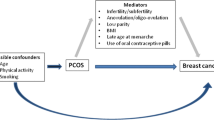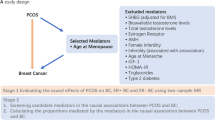Abstract
Purpose
The goal of this study was focused on two subjects. First, to determine possible association between PCOS and family history of breast cancer, ovarian cancer, endometrial cancer, heart attack, thrombosis, diabetes and cardiovascular disease (CVD). Second, to evaluate maternal and paternal transmission in PCOS patients with positive family history of a disease.
Methods
A cross-sectional study was conducted in 549 infertile women (273 with PCOS and 276 controls) in Arash hospital of Tehran, Iran, between 2007 and 2008 by using questionnaire.
Results
In this analysis, there were significantly increased number of women with the positive family history of diabetes among PCOS group (28.21% vs. 19.20%, p = 0.01). Meanwhile, four women in PCOS group had self history of diabetes while no one in the control group reported diabetes. A statistically significant positive family history of breast cancer was found among the control group (4.35% vs. 1.30%, p = 0.02). Endometrial cancer and diabetes were observed in mother or mother’s side of the family but heart attack and thrombosis manifested in father or father’s side of the family more. There were no statistically significant differences in a positive individual or family history of ovarian cancer, endometrial cancer, heart attack, thrombosis and CVD between the two groups.
Conclusion
In the present study, women and their relatives with PCOS had an increased prevalence of diabetes and it is more common in mother’s side of the family.
Similar content being viewed by others
References
Pierpoint T, McKeigue PM, Issaca AJ. Wild SH, Jacobs HS, editors. Mortality in women with polycystic ovary syndrome at long-term follow-up. J Clin Epidemiol. 1998;51:581–6.
Dahlgren E, Johansson S, Lindstedt G, Kutsson F, Oden A, Janson PO, Mattson LA, Crona N, Lundberg PA. Women with polycystic ovary syndrome wedge resected in 1956 to 1965: a long-term follow-up focusing on natural history and circulating hormones. Fertil Steril. 1992;57:505–13.
Legro RS, Spielman R, Urbanek M. Driscoll d, Strauss IIIJF, Dunaif A: Phenotype and genotype in polycystic ovary syndrome. Recent Prog Horm Res. 1998;53:217–56.
Franks S, McCarthy M. genetics of ovarian disorders: polycystic ovary syndrome. Rev Endocr Metab Disord. 2004;5:49–52. doi:10.1023/B:REMD.0000016125.05878.96.
Tsanadis G, Vartholomatos G, Korkontzelos I, Avgoustatos F, Kakosimos G, Sotiriadis A, Tatsioni A, Eleftheriou A, Lolis D. polycystic ovarian syndrome and thrombophilia. Hum Reprod. 2002;17:314–9. doi:10.1093/humrep/17.2.314.
Atiomo WU, Condon J, Adekanmi O, Friend J, Wilkin TJ, Prentic AG. Are women with polycystic ovary syndrome resistant to activated protein C? Fertil Steril 2000;74:1229–32. doi:10.1016/S0015-0282(00)01614-9.
Baron JA, Wiederpass E, Newcomb PA, Stampfer M, Titus-Ernstoff L, Egan KM, Greenberg ER. Metabolic disorders and breast cancer risk (United States). Cancer Causes Control. 2001;12:875–80. doi:10.1023/A:1013796112348.
Atiomo WU, El-Mahdi E, Hardiman P. Familial associations in women with polycystic ovary syndrome. Fertil Steril. 2003;80:143–5. doi:10.1016/S0015-0282(03)00502-8.
Hunter A, Vimplis S, Sharma A, Eid N, Atiomo W. To determine whether first-degree male relatives of women with polycystic ovary syndrome are at higher risk of developing cardiovascular disease and type II diabetes mellitus. J Obstet Gynaecol. 2007;27:591–6. doi:10.1080/01443610701497520.
Revised 2003 Consensus on diagnosis criteria and long-term health risks related to polycystic ovary syndrome (PCOS). Hum Reprod. 2004;19:41–7. doi:10.1093/humrep/deh098.
Norman RJ, Masters S, Hague W. Hyperinsulinemia is common in family members of women with polycystic ovary syndrome. Fertil Steril. 1996;66:942–7.
Collina S, Cox NJ, Ehrmann DA. Heritability of insuline secretion and insuline action in women with polycystic ovary syndrome and their first degree relatives. J Clin Endocrinol Metab 2001;86:2027–31. doi:10.1210/jc.86.5.2027.
Daniel WF. Diabetes mellitus. In: Braunwald E, Issel backer KJ, Petersdorf RG, editors. Harrison’s principles of internal medicine. 14th ed. New York: McGraw-Hill; 1998. p. 2060–80.
Ostovan MA. Familial inheritance in diabetes mellitus in South Iranian population. SEMJ 2007;8:151–4. (http://semj.sums.ac.ir/vol8/oct2007/dm.htm).
American Diabetes Association. Screening for diabetes. Diabetes Care 2002;25:21–4. doi:10.2337/diacare.25.2007.S21.
Wild S, Roglic G, Green A, Sicree R, King H. Global prevalence of diabetes: estimates for the year 2000 and projections for 2030. Diabetes Care. 2004;27:1047–53. doi:10.2337/diacare.27.5.1047.
Brinton LA, Devesa SS. Etiology and pathogenesis of breast cancer. Disease of the breast. 1st ed. Philadelphia: lippincott-Raven; 1996. p. 159–68.
Henderson BE, Bernstein L. Endogenous and expgenous hormonal factors. In: Harris JR, Lipppman ME, Morrow M, Hellman S, editors. Disease of the breast. 1st ed. Philadelphia: lippincott-Raven; 1996. p. 185–200.
Wiseman RA. Breast cancer: critical data analysis concludes that esterogens are not the cause, however lifestyle changes can alter risk rapidly. J Clin Epidemiol. 2004;57:766–72. doi:10.1016/j.jclinepi.2003.10.017.
Michels DF, Terry KL, Willett WC. Longitudinal study on the role of body size in premenopausal breast cancer. Arch Intern Med. 2006;166:2395–402. doi:10.1001/archinte.166.21.2395.
Roses DF. Breast cancer. In: Spicer DV, Pike MC, editors. Risk factors for development of breast cancer. 2nd ed. Churchill Livingstone. 2005; 49–50.
McCormack VA, Perry N, Vinnicombe SJ, Silva Idos S. Ethnic variations in mammographic density: a British multiethnic longitudinal study. Am J Epidemiol. 2008;168:412–21. doi:10.1093/aje/kwn169.
Maskarinec G, Meng L, Ursin G. Ethnic differences in mammographic densities. Int J Epidemiol. 2001;30:959–65. doi:10.1093/ije/30.5.959.
Acknowledgment
This research has been supported by Tehran University of Medical Sciences and we would like to thank the staff of Arash Hospital for their cooperation throughout the stages of the study.
Author information
Authors and Affiliations
Corresponding author
Additional information
Capsule
In the present study, women and their relatives with PCOS had an increased prevalence of diabetes and it is more common in mother’s side of the family.
Rights and permissions
About this article
Cite this article
Moini, A., Eslami, B. Familial associations between polycystic ovarian syndrome and common diseases. J Assist Reprod Genet 26, 123–127 (2009). https://doi.org/10.1007/s10815-009-9297-7
Received:
Accepted:
Published:
Issue Date:
DOI: https://doi.org/10.1007/s10815-009-9297-7




